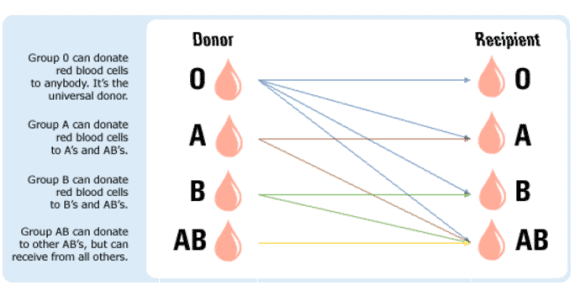You’ll know if you’re an A or a B grade student, but do you know if you’re type A, B, AB or O when it comes to your blood? There’s a pretty simple test to find out…as these Carrington Medical Laboratory Technician (MLT) program [1] students explain.
Why do I need to know my blood type?
Everyone’s blood is made of the same basic stuff and it’s usually red right? But did you know that not all blood is the same? There are actually eight different common blood types, and it’s important to know what type you are. Here’s Medical Laboratory Technician student Erica to tell you why. “It’s important to know your blood type for blood transfusions, transplants, donation and paternity.” So if you are ever in an accident or need surgery, it’s important that you and your loved ones know your blood type. If you’ve ever donated blood, then you should know. They test your type when you first donate. Why? Because you can’t mix certain types of blood. It can be deadly! Your blood type comes from your parents – like the color of your eyes it’s inherited. Whether your blood group is type A, B, AB or O is based on the blood types of your mother and father.
So how do you type blood? What’s the test?
Working with blood samples (hematology) and learning how to type blood is one of the most important parts of the job for a medical lab tech working in a hospital, physician’s office or in independent lab. MLT student Cheryl to tell you how to check blood type. It’s pretty quick, the test only takes about ten minutes. “You take a reagent [a substance used to test for the presence of another substance by causing a chemical reaction] and you mix it with red cells from the patient; you spin in down in a centrifuge, take it out and look at it and check it against its agglutination.” Agglutination? What in the world is that Cheryl? “Agglutination is how your antigens and your antibodies combine – if they connect or not.” It sounds pretty complex to you and me, but once you get into the MLT program it becomes second nature. If you become a medical lab tech, your job may require you to draw a patient’s blood too, not just test it. Student Marisella explains that’s pretty hard to start with; “The first initial poke was the hardest, but after that it’s just learning how to do it without hurting anybody!”
What’s different about each blood type?
The eight different common blood types are determined by whether the blood has certain antigens or not. So what’s an antigen? It’s a substance that can trigger a response from your body’s immune system if that antigen is alien to your body. That’s why you can’t mix certain blood types in a transfusion; some antigens can trigger the immune system to attack the blood being introduced to your body…and that’s not cool! Here’s information from the American Red Cross2 explaining what blood type has what antigen.
- Group A – has only the A antigen on red cells (and B antibody in the plasma)
- Group B – has only the B antigen on red cells (and A antibody in the plasma)
- Group AB – has both A and B antigens on red cells (but neither A nor B antibody in the plasma)
- Group O – has neither A nor B antigens on red cells (but both A and B antibody are in the plasma)
You still with us? This is interesting stuff right? It’s not just A, B, AB or O you need to know! O no! See what we did there… As well as the A and B antigens, there’s a third called the Rh factor, which can be either present (+) or absent (–). That’s what the A+, B+ or O- means if you know your blood type. In general, Rh negative blood is given to Rh-negative patients, and Rh positive blood or Rh negative blood may be given to Rh positive patients.[2]
So who can donate blood to who?
The easiest way to answer that is with this image from the American Red Cross.2 If you have type O blood then you can donate to anyone – you’re a universal donor. But you can see now why it’s important to know your blood type. 
What’s the most common blood type?
The easy answer to that question is O+ – that’s the most common blood type. But it’s not as easy as that because as blood type does vary according to your ethnicity. Hispanic people, for example, have a relatively high number of O’s, while Asian people have a relatively high number of B’s. The chart below[3], again thanks to the American Red Cross, shows the mix of the different blood types in the U.S. population:
| Blood Type | Caucasian | African-American | Hispanic | Asian |
|---|---|---|---|---|
| O + | 37% | 47% | 53% | 39% |
| O – | 8% | 4% | 4% | 1% |
| A + | 33% | 24% | 29% | 27% |
| A – | 7% | 2% | 2% | 0.5% |
| B + | 9% | 18% | 9% | 25% |
| B – | 2% | 1% | 1% | 0.4% |
| AB + | 3% | 4% | 2% | 7% |
| AB – | 1% | 0.3% | 0.2% | 0.1% |
| Source – American Red Cross |
So where can I get a blood type test?
The easiest is to ask your family doctor; they may have it on file, or you can request a blood test. If you don’t have a primary care doctor, you can have a blood test done at a health clinic. But the best way is to donate blood! Why? Because you can find your answer and help other people at the same time. Donating blood is very important, especially if you do have a rare blood type. Find a local donation center and when you go in, mention that you want to know your blood type when you’re done. Alternatively wait until your local Carrington College campus hosts their next blood drive!
[1] Important information about the educational debt, earnings and completion rate of students who attended this program can be found at carrington.edu/cc/mlt. [2] Information courtesy of http://www.redcrossblood.org/learn-about-blood/blood-types [3] http://www.redcrossblood.org/learn-about-blood/blood-types



